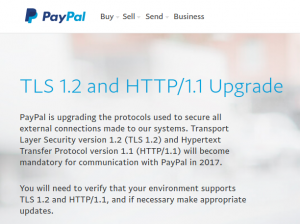

- #Php test tls 1.2 install
- #Php test tls 1.2 update
- #Php test tls 1.2 driver
- #Php test tls 1.2 Patch
- #Php test tls 1.2 upgrade
Confirm the registry settings, but no additional changes are required. NET Framework 4.6.2 and later supports TLS 1.1 and TLS 1.2. NET Framework might require updates to enable strong cryptography. NET updates so you can enable strong cryptography. For more information, see Determine which versions and service pack levels of. NET versionįirst, determine the installed. NET Framework to support TLS 1.2 Determine. For more information on disabling TLS 1.0 and 1.1, see Configuring Schannel protocols in the Windows Registry. NET registry values are set to enable TLS 1.2 and verify the environment is properly utilizing TLS 1.2 on the network, you may want to edit the SChannel\Protocols registry key to disable the older, less secure protocols. TLS 1.2 is enabled by default at the operating system level. Ensure that TLS 1.2 is enabled as a protocol for SChannel at the operating system levelįor the most part, protocol usage is controlled at three levels, the operating system level, the framework or platform level, and the application level. For more information, see Restrict the use of certain cryptographic algorithms and protocols in Schannel.dll. If you want to completely disable SSL 3.0 and TLS 1.0, use the SChannel disabled protocols setting in Windows. Configuration Manager supports the most secure protocol that Windows negotiates between both devices.

You can use the value of 0xA00 to only enable TLS 1.1 and TLS 1.2. This configuration ensures that the change doesn't break any other application that might still rely on SSL 3.0 or TLS 1.0. The above example keeps these defaults, and also enables TLS 1.1 and TLS 1.2 for WinHTTP. By default in Windows, this value is 0x0A0 to enable SSL 3.0 and TLS 1.0 for WinHTTP.
#Php test tls 1.2 update
Update to enable TLS 1.1 and TLS 1.2 as default secure protocols in WinHTTP in Windows lists the hexadecimal value for each protocol. The example above shows the value of 0xAA0 for the WinHTTP DefaultSecureProtocols setting. If you change this value, restart the computer. HKEY_LOCAL_MACHINE\SOFTWARE\Wow6432Node\Microsoft\Windows\CurrentVersion\Internet Settings\WinHttp\ Verify the value of the DefaultSecureProtocols registry setting, for example: HKEY_LOCAL_MACHINE\SOFTWARE\Microsoft\Windows\CurrentVersion\Internet Settings\WinHttp\ Otherwise, you can inadvertently orphan them.
#Php test tls 1.2 Patch
With the patch installed, create the following registry values:Įnable these settings on all clients running earlier versions of Windows before enabling TLS 1.2 and disabling the older protocols on the Configuration Manager servers.
#Php test tls 1.2 install
For these earlier versions of Windows, install Update 3140245 to enable the registry value below, which can be set to add TLS 1.1 and TLS 1.2 to the default secure protocols list for WinHTTP. Windows 8.1, Windows Server 2012 R2, Windows 10, Windows Server 2016, and later versions of Windows natively support TLS 1.2 for client-server communications over WinHTTP.Įarlier versions of Windows, such as Windows 7 or Windows Server 2012, don't enable TLS 1.1 or TLS 1.2 by default for secure communications using WinHTTP. NET Framework to support TLS 1.2įor more information about dependencies for specific Configuration Manager features and scenarios, see About enabling TLS 1.2.

#Php test tls 1.2 upgrade
Note: Before you upgrade to Enterprise Vault 12.4.1, ensure that you install MSOLEDBSQL on the computers that host the Enterprise Vault server. This document applies to Enterprise Vault 12.4.1 and later. This document provides information about enabling TLS 1.2 on the computers that host the Enterprise Vault server.
#Php test tls 1.2 driver
To support TLS 1.2, the Microsoft OLE DB Provider for SQL Server (SQLOLEDB) is replaced with the Microsoft OLE DB Driver for SQL Server (MSOLEDBSQL). Enterprise Vault 12.4.1 and later support the TLS 1.2 protocol for communication between the Enterprise Vault components and the SQL server.


 0 kommentar(er)
0 kommentar(er)
